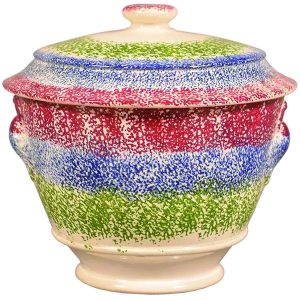ANTIQUES AND COLLECTING: Antique, vintage ceramics are difficult to identify
By Terry and Kim Kovel — July 16, 2022
Spatterware is a pottery decorated with paint that is actually spattered on the plate by flicking a stick dipped in the paint. (Photo courtesy of Conestoga Auction Group/kovels.com)
It is not easy to identify antique and vintage ceramics, because many were made by small local potteries and not marked. Workmen often moved to another factory but continued to make the same type of wares and decoration.
Spatterware is a pottery decorated with paint that is actually spattered on the plate by flicking a stick dipped in the paint. Very similar decorations were made by dabbing paint on with a sponge. Many collectors think spatter and sponge are the same, so you must check any written descriptions. Both are popular vintage collectibles.
Both types of folk pottery were made in the early 1800s in Scotland, Italy, Holland, France and the United States. Similar dinnerware and other household dishes are still being made but with the help of machines, not often by hand. Tulips are often pictured either as part of a border or as a single flower in the center. Price is determined by the condition and the skill of the decorator.
Conestoga Auction Co. sold a collection of this type of pottery, with many early examples selling for hundreds of dollars. A plate with a border of green and blue spatter stripes and a center with two stylized tulips did not have a maker’s mark and sold for $224.
***
Q: After my mother died, we found a Pairpoint lamp in a box in the attic. It looks original except for the cord. There are two stamps under the shade dated July 9, 1901. It has puffy butterflies. The base has a diamond-shaped stamp underneath. Can you tell me what this might be worth?
A: Thomas J. Pairpoint founded the Pairpoint Manufacturing Company in New Bedford, Massachusetts, in 1880. The company joined with nearby glassworks and made glass, lamps and silver-plated pieces. Reverse-painted glass shades and molded shades known as “puffies” were made until the 1930s. The company became the Pairpoint Glass Company in 1957. It moved to Sagamore, Massachusetts, in 1970 and now makes luxury glass items. Look closely at the patent date on your lamp. Are you sure it’s not 1907? Pairpoint’s Papillon (butterfly) boudoir lamp marked “patented July 9th — 1907” sells at auction for about $2,000.
***
CURRENT PRICES
Candy container, Easter Bunny pulling cart, papier-mache, glass eyes, wood cart with mossy sides, holds decorated tin eggs, bunny’s head removes, Germany, 13 inches, $375.
Staffordshire creamer, cow shape, curled tail, calf feeding, cream color with marbled agate glaze, 1800s, 5 x 8 inches, $550.
Tiffany glass vase, gold iridescent, wide top, dimpled sides, deeply ruffled rim, spread foot, signed “L.C. Tiffany Favrile,” 4 x 4 1/2 inches, $625.
Candy container, Easter Bunny, glass eyes, standing on platform, egg and chick in basket, Germany, 9 inches, $840.
***
TIP: Use a soft bristle toothbrush to clean hard-to-reach spots on silver or jewelry.
Looking to declutter, downsize or settle an estate? Kovels’ Antiques & Collectibles Price Guide 2022 by Terry and Kim Kovel has the resources you’re looking for.
© 2022 King Features S







